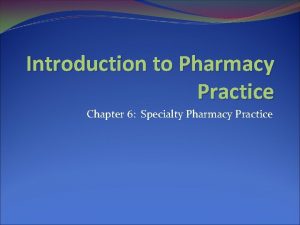Principles of pharmacy practice Lec 1 Lecturer Dr
















- Slides: 16

Principles of pharmacy practice Lec 1 Lecturer Dr Athmar Dhahir Habeeb Al-Shohani Ph. D in industrial pharmacy and pharmaceutical formulations athmar 1978@uomustansiriyah. edu. iq athmar 1978@yahoo. com athmar. habeeb. 12@ucl. ac. uk

Density, Specific Gravity, and Specific Volume Density (d) is mass per unit volume of a substance. It is usually expressed as grams per cubic centimeter (g/cc). Because the gram is defined as the mass of 1 cc of water at 4 o. C, the density of water is 1 g/cc. For our purposes, because the United States Pharmacopeia 1 states that 1 m. L may be used as the equivalent of 1 cc, the density of water may be expressed as 1 g/m. L Density may be calculated by dividing mass by volume, that is:

• Thus, if 10 m. L of sulfuric acid weighs 18 g, its density is:

Specific gravity (sp gr) is a ratio, expressed decimally, of the weight of a substance to the weight of an equal volume of a substance chosen as a standard, both substances at the same temperature or the temperature of each being known. Water is used as the standard for the specific gravities of liquids and solids; the most useful standard for gases is hydrogen. Specific gravity may be calculated by dividing the weight of a given substance by the weight of an equal volume of water, that is:

• Thus, if 10 m. L of sulfuric acid weighs 18 g, and 10 m. L of water, under similar conditions, weighs 10 g, the specific gravity of the acid is: • Substances that have a specific gravity less than 1 are lighter than water. • Substances that have a specific gravity greater than 1 are heavier than water

* If 54. 96 m. L of oil weighs 52. 78 g, what is the specific gravity of the oil? 54. 96 m. L of water weighs 54. 96 g Specific gravity of oil= 52. 78 (g)/ 54. 96 (g) = 0. 9603, answer. * If a pint of a certain liquid weighs 601 g, what is the specific gravity of the liquid? 1 pint =473 m. L of water weighs 473 g Specific gravity of liquid= 601 (g) /473 (g) = 1. 27, answer.

Pycnometer or Specific Gravity Bottle A pycnometer is a special glass bottle used to determine specific gravity. Pycnometers are generally available for laboratory use in volumes ranging from 1 m. L to 50 m. L. Pycnometers have fitted glass stoppers with a capillary opening to allow trapped air and excess fluid to escape. Some pycnometers have thermometers affixed, because temperature is a factor in specific gravity determinations.

Example: A 50 m. L pycnometer is found to weigh 120 g when empty, 171 g when filled with water, and 160 g when filled with an unknown liquid. Calculate the specific gravity of the unknown liquid. Weight of water: 171 g - 120 g = 51 g Weight of unknown liquid: 160 g - 120 g = 40 g Specific gravity= Weight of substance/ Weight of equal volume of water Specific gravity of unknown liquid = 40 (g)/ 51 (g) = 0. 78, answer.

Calculating Weight, Knowing the Volume and Specific Gravity Grams = Milliliters × Specific gravity Grams (other liquid)= Grams (of equal volume of water) × Specific gravity (other liquid) Example: What is the weight, in grams, of 2 fl. oz. of a liquid having a specific gravity of 1. 118? 2 × 29. 57 m. L =59. 14 m. L of water weigh 59. 14 g × 1. 118 =66. 12 g, answer. What is the cost of 1000 m. L of glycerin, specific gravity 1. 25, bought at $54. 25 per pound? 1000 m. L of water weigh 1000 g Weight of 1000 m. L of glycerin =1000 g × 1. 25 =1250 g 1 lb =454 g 454 (g) /1250 (g) = ($) 54. 25 ($) /x x = $149. 37, answer





Calculating Specific Volume Specific volume, in pharmaceutical practice, is usually defined as an abstract number representing the ratio, expressed decimally, of the volume of a substance to the volume of an equal weight of another substance taken as a standard, both having the same temperature. Water is the standard. Example: Calculate the specific volume of a syrup, 91. 0 m. L of which weighs 107. 16 g of water measures= 107. 16 m. L Specific volume of syrup = 91. 0 (m. L) /107. 16 (m. L) = 0. 849, answer

Because specific gravity and specific volume are reciprocals, a substance that is heavier than water will have a higher specific gravity and a lower specific volume, whereas a substance that is lighter than water will have a lower specific gravity and a higher specific volume. It follows, therefore, that we may determine the specific volume of a substance by dividing 1 by its specific gravity, and we may determine the specific gravity of a substance by dividing 1 by its specific volume.

 Lecturer's name
Lecturer's name Physician associate lecturer
Physician associate lecturer Spe distinguished lecturer
Spe distinguished lecturer Good afternoon teachers
Good afternoon teachers Photography lecturer
Photography lecturer Lecturer in charge
Lecturer in charge Designation lecturer
Designation lecturer Designation of lecturer
Designation of lecturer Gcwak
Gcwak Lecturer name
Lecturer name Pearson lecturer resources
Pearson lecturer resources Spe distinguished lecturer
Spe distinguished lecturer Lector vs lecturer
Lector vs lecturer Lecturer in charge
Lecturer in charge Cfa lecturer handbook
Cfa lecturer handbook Lecturer asad ali
Lecturer asad ali Lec scoreboard
Lec scoreboard































